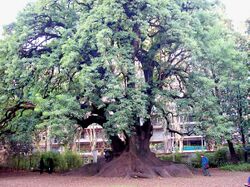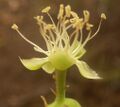Biology:Phytolacca dioica
| Phytolacca dioica | |
|---|---|

| |
| A specimen, more than 80 years old, in Buenos Aires, Argentina | |
| Scientific classification | |
| Kingdom: | Plantae |
| Clade: | Tracheophytes |
| Clade: | Angiosperms |
| Clade: | Eudicots |
| Order: | Caryophyllales |
| Family: | Phytolaccaceae |
| Genus: | Phytolacca |
| Species: | P. dioica
|
| Binomial name | |
| Phytolacca dioica | |
| Synonyms | |
|
Pircunia dioica Moq. | |
Phytolacca dioica, commonly known as ombú in Spanish and umbu in Portuguese, is a massive evergreen tree in the Pokeweed Family (Phytolaccaceae) native to the Pampas of South America. As its specific epithet suggests, it is dioecious, with male and female flowers on separate plants.[1] The flowers are pollinated by the butterfly Doxocopa laurentia. It has an umbrella-like canopy that spreads to a diameter of 12 to 15 meters (40 to 50 feet) and can attain a height of 12 to 18 meters (40 to 60 feet). This upper growth springs up from a tuberous caudex which, according to Everett "may occupy a circle sixty feet [18 meters] in diameter".[2] One tree of such a size is mentioned by Anglo-Argentine writer William Henry Hudson in his autobiography " Far Away and Long Ago", which was fifty feet (fifteen meters) girth above the caudex.[3] Because it is derived from herbaceous ancestors, its trunk consists of anomalous secondary thickening rather than true wood. As a result, the ombú grows fast but its wood is soft and spongy enough to be cut with a knife. These properties have led it to be used in the art of bonsai, as it is easily manipulated to create the desired effect. Since the sap is poisonous, the ombú is not grazed by cattle and is immune to locusts and other pests. For similar reasons, the leaves are sometimes used as a laxative or purgative. It is a symbol of Uruguay, Rio Grande do Sul and Argentina , and of gaucho culture, as its canopy is quite distinguishable from afar and provides comfort and shelter from sun and rain.
This tree is categorized in the same genus as the North American pokeweed. The species is also cultivated in Southern California as a shade tree. Ombú has been declared as a minor invasive species (category 3) in South Africa, where it is widely planted.[4]
Gallery
-
Magenta petioles and leaf venation
-
Flower
-
Inflorescence and fruit
-
Infructescence and seeds – MHNT
References
- ↑ "Phytolacca dioica Tree Record". SelecTree. https://selectree.calpoly.edu/tree-detail/phytolacca-dioica.
- ↑ Everett, Thomas H. (1968). Living Trees of the World. New York: Doubleday and Co.. p. 144.
- ↑ Hudson, William H. (1918). Long Ago, Far Away. New York: E.P. Dutton. p. 5.
- ↑ Glen, Hugh & Van Wyk, Braam (2016) Guide to Trees introduced into South Africa. pp.232-233. Struik Nature, Cape Town
Wikidata ☰ Q937654 entry
 |





